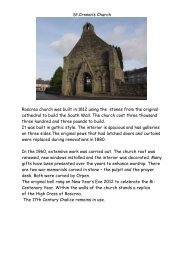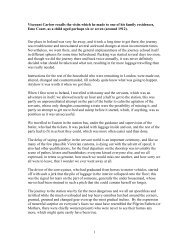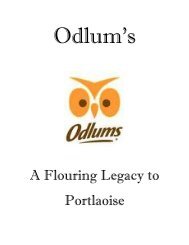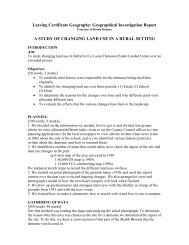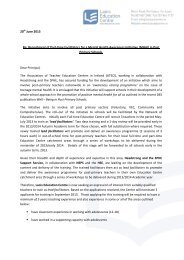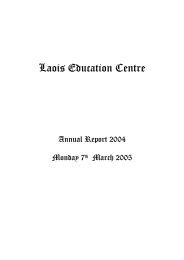Monaincha the 31st Wonder of the World - Laois education Centre
Monaincha the 31st Wonder of the World - Laois education Centre
Monaincha the 31st Wonder of the World - Laois education Centre
Create successful ePaper yourself
Turn your PDF publications into a flip-book with our unique Google optimized e-Paper software.
<strong>the</strong>y found him. Unfortunately <strong>the</strong> man did become ill so he told<br />
people about Cannice. The monks came from Kilkenny and took<br />
Cannice back to <strong>the</strong> monastery.<br />
Sometime after, when St.Cannice was visiting St.Columba on <strong>the</strong><br />
island <strong>of</strong> lona in Scotland, St.Columba asked him how he knew and<br />
understood <strong>the</strong> scriptures so well. St Cannice replied that <strong>the</strong> Lord<br />
came to him on <strong>the</strong> island <strong>of</strong> <strong>Monaincha</strong> and explained <strong>the</strong> scriptures<br />
to him in great detail. Following this <strong>the</strong> island became a famous<br />
place for prayer and retreat. In <strong>the</strong> 8th century <strong>the</strong> Culdee<br />
movement came to Roscrea under <strong>the</strong> leadership <strong>of</strong> <strong>the</strong> hermit Hilary.<br />
Hilary believed that <strong>the</strong>y should live a stricter lifestyle, so he moved<br />
out to <strong>Monaincha</strong>. Here <strong>the</strong>y lived a strict religious life. Hilary died<br />
in 807 and <strong>the</strong> Culdees were wiped out at <strong>the</strong> end <strong>of</strong> <strong>the</strong> Viking raids.<br />
However, <strong>the</strong> sanctity <strong>of</strong> <strong>the</strong> island remained. In <strong>the</strong> 12th century<br />
<strong>the</strong> Augustinian Canons came, and in 1190 The Hiberno-Romanesque<br />
Church was built.<br />
The build is a great example <strong>of</strong> an early 12th century church with a<br />
later addition. The nave and chancel are both 12th century but <strong>the</strong><br />
sacristy is a later addition featuring a gothic pointed arch. The<br />
sandstone doorway is highly ornate. The door is made up <strong>of</strong> four<br />
entwined archways each with <strong>the</strong>ir own intricate design. The<br />
windows in <strong>the</strong> nave are 13th century. There is a High Cross similar<br />
to <strong>the</strong> Roscrea Cross, located opposite to <strong>the</strong> doorway. The cross<br />
bears a clo<strong>the</strong>d figure <strong>of</strong> Christ. The base is possibly 10th century or<br />
earlier. The top half with <strong>the</strong> figure is 12th century and <strong>the</strong> shaft,<br />
in an attempt to preserve it, is 20th century cement!<br />
In <strong>the</strong> 17th century <strong>the</strong> island became internationally known for<br />
pilgrimage. It became more famous than Knock! During <strong>the</strong> 17th and<br />
18th century it was used as a church.<br />
The Birch Family bought <strong>Monaincha</strong> and <strong>the</strong> surrounding land in 1780.<br />
The <strong>Monaincha</strong> bog was drained in <strong>the</strong> 1800’s by <strong>the</strong> Birch Family.<br />
The lake disappeared. The island became a small mound built with <strong>the</strong><br />
remains <strong>of</strong> <strong>the</strong> dead. The surrounding area was used as a rifle range<br />
by <strong>the</strong> town garrison. When it was drained a pilgrim’s bottle was<br />
found. This is now housed in <strong>the</strong> National Museum.



